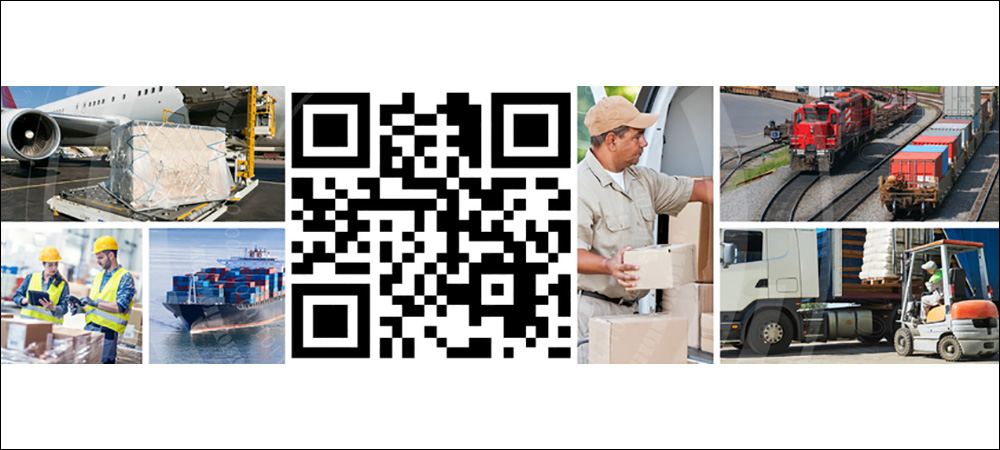Ed. Note: This article was previously posted at IoP Journal.
GS1 Australia is testing with several countries what it calls Scan4Transport, a global standard for encoding transport data on a logistics label. The standard supports companies throughout the transport process, including first-mile, sortation and last-mile activities, enabling them to keep pace with the growing needs of their customers. The Scan4Transport standard allows the capture of the core data required to complete a transport task, with the scan of a 2D barcode on a standards-based transport label.
Transport data, including address information, authority to leave, and so forth, is encoded into a 2D barcode symbol (a GS1 DataMatrix or QR code) on the transport label, facilitating the transport of all sorts of freight, including satchels, cartons and pallets. “RFID can be used in conjunction with barcodes, but it will require more standard documentation to be developed,” says Michiel Ruighaver, the transport and logistics manager of GS1 Australia’s Scan4Transport Centre of Excellence.

Michiel Ruighaver
2D barcodes can have large amounts of data embedded within; one type is the GS1 DataMatrix. Such barcodes are particularly useful for storing information relevant to the transport process (e.g. ship to address, dangerous goods information, weight), as they enable information to be available in both online and offline environments with the scan of a barcode. New application identifiers released as part of this standard unambiguously indicate the meaning of the data element following them, enabling this data to be encoded in a globally standard manner that all stakeholders can understand.
With the standards developed for the transport label, the possible benefits include improved first- and last-mile processes during the capture of essential information related to the transport task from the barcode on the transport label (e.g. when the freight is handled and scanned before the electronic instructions have been received). Scan4Transport enhances sortation through the capture of granular address information, gives visibility of transport task requirements even if remote IT systems are unavailable for lookup, and improves efficiency and interoperability throughout the industry via a standard label across the entire supply chain. “All this leads to smoother processes and greater customer satisfaction,” Ruighaver explains.
“Following feedback from shippers and logistic service providers seeking a more standardized approach to encoding key transport information in a 2D barcode on the logistics label,” Ruighaver states, “GS1 Australia initiated a work request in 2018 to have GS1 supply chain standards developed.” The Scan4Transport Global Working Group was subsequently established in January 2019, chaired by Ruighaver.
“The group has representatives from logistic service providers, shippers, solution providers and GS1 member organizations from around the world,” Ruighaver says, “and is focused on enabling improved efficiency, interoperability, connectivity and visibility challenges across the freight and logistics process due to the fragmented nature of the industry. The Scan4Transport standards developed were ratified in August 2020.”

The Scan4Transport standard allows the capture of the core data required to complete a transport task, with the scan of a 2D barcode on a standards-based transport label.
A global industry workgroup—containing members from freight transport companies around the world, including AusPost, DHL, Correios Brazil and VT Freight Express—developed new application identifiers for encoding transport data on the logistics label. They also developed a new implementation guideline and pilot report which outlines how to leverage the GS1 Digital Link standard within a 2D barcode on the logistics label.
These standards focus on improving efficiency, interoperability and visibility across the transport process, particularly in last-mile activities. The group had broad representation and support from shippers, logistic service providers, solution providers and GS1 member organizations from more than 22 countries around the world. It promises to bring improved efficiencies across the sector.
According to Odarci Roque de Maia Jr., the RFID project manager at Correios Brazil, “The Scan4Transport standards represent the possibility of using market-standardized and interoperable technology. Its use in the future will certainly allow the company to properly operate its processes, providing adequate logistics services to its customers, even in unfavorable technical conditions, such as remote locations (e.g. rural areas) where there is poor coverage of cellular telephony signals and/or data communication, or in contingency situations (e.g. loss of connectivity or communications).”
Karl Brooks, DHL Supply Chain Australia’s IT solutions architect, adds, “The Scan4Transport standards will provide additional resilience at times when electronic transport instructions have not been received. This includes our automated sortation and routing processes, as well as first- and final-mile execution. Scan4Transport will also enhance the partner carriers processes we work with in the same way. The end result will be enhancing the quality of service for our customers throughout their supply chains.”
Click here to watch an IoP Journal exclusive interview with Ruighaver. Click here to watch “Scan4Transport—A Tale of Two Labels,” which compares traditional freight transport labels with the Scan4Transport labels. Click here to watch “Scan4Transport Pilot Report” to learn about the pilots and workgroup. And click here to visit the Scan4Transport website, which contains links to the guideline, tools to support pilots and implementation, and other useful information.

